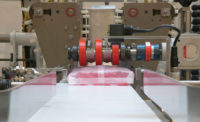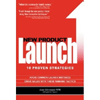At the heart of every web converting process lie precision rollers. Designed to carry the web, laminate or coat it, cool it, heat it, or treat it, these cylindrical objects must be engineered and constructed with an exact eye for detail in order to meet the unique demands of any given application and system.
Yet, the demands placed on any single roller can be quite different from roller to roller and system to system. Consequently, specifying the right precision roller (or rollers) is not always easy. Experience is one of the primary keys to proper specification. Knowing the details of your own process, and combining that with the knowledge of an experienced supplier, will lead to an optimum solution.
Use this checklist to aid in specifying the key parameters of each roller and in evaluating the expertise of your supplier. These 10 most critical roller specifications will assist the converter in matching optimum roller performance to system fit and function:
APPLICATION: As an example, when converters explain that higher temperatures are involved (as in oven applications), the roller supplier knows that linear expansion can cause binding, and special bearings might be required. Likewise, when the roller is to be used in a coating process, finer surface finishes and critical concentricity are implied.
QUANTITY: We have observed that very frequently spare rollers are required less than one year from installation. Don’t forget that the cost of machine downtime can often far outweigh the cost of a replacement roller. There can also be substantial cost savings in manufacturing spare rollers as part of the original order. Typically, the higher the quantity, the lower the unit cost. For this reason alone, be prepared to review your roller quantities — even if it’s just to compare your pricing options.
ROLLER MATERIAL: Carbon steel, aluminum, stainless steel and carbon fiber are examples of material options frequently chosen. The material selected for your roller must be a fine balance between actual strength requirements, desired performance features and cost. For example, aluminum rollers offer low inertia and natural corrosion resistance but sacrifice strength and durability compared to steel rollers. Steel rollers are durable and strong but can have corrosion problems in many applications. Several coating options are available to give each type of roll better performance characteristics. Stainless steel and carbon fiber provide high performance features but are much more expensive. Be aware that there is a broad range of materials available. Be sure there is existing experience with the material selected for your specific application. Feel free to ask your supplier for recommendations — even if you’re confident you’ve selected the right material. Better to tap into their knowledge than to assume your specifications are infallible.
LOADING: This is probably the single most important factor, since it determines how a roller should be constructed. Loading, or the external forces exerted on a roll, will influence wall thickness, journal diameter, header thickness, roller diameter, material selection and more. Start by identifying nip loads and their direction. Know your web tension. Also, the amount of wrap will be important (a description such as “9 o’clock to 3 o’clock wrap over the top” is usually adequate). Identify all known or desired journal sizes. Knowing bearing types and the distance between them may also be important. In the end, your roller must be designed and constructed to support these loads within the parameters of your process. Consequently, the cost of your roller will directly reflect the cost of materials used to meet these specs.
SPEED: Just because a roller is balanced doesn’t mean it will run with optimum efficiency at all speeds. Simply stated, every roller should be balanced to match the intended line speed range. Attempt to calculate all possible speeds before having your roller dynamically balanced to merely handle present speed requirements. It’s likely that precision balancing, when properly done, will accommodate a wide range of line speeds. When small-diameter rolls with heavier loads and wider webs come into play, “critical speed” may become a concern. Be certain these factors are calculated and taken into account in the final design.
SURFACE FINISHING: A general rule of thumb states that, with all other specifications being equal, the finer the surface finish, the more expensive the roller. Special surface coverings and modifications also add cost, but comparative costs are not always apparent. For example, a rubber-covered roller needs only to be turned before covering, while a precision chrome-plated roller requires grinding both before and after plating. Many times an engineer can solve particular challenges, such as wrinkling, with custom surface treatments. An example of this is a machined grooved surface finish. By understanding the end use of your roller, the roller supplier can specify the most economical and functional finish for the application.
COATINGS & COVERINGS: The roller manufacturing process changes whenever different coverings and coatings are involved. For this simple reason, don’t hesitate to discuss your intentions to add special coatings or coverings, even if these services are scheduled to be completed through another supplier. For example, rollers to be rubber coated typically shouldn’t get a costly ground finish but merely a turning of the O.D. (outer diameter), resulting in a better rubber-bonding surface. Rubber-covered rollers should be made with a vent hole to prevent moisture trapped in the roller from turning into pressurized steam during the vulcanizing process. When covering rolls with rubber, roller journals can be marred or scratched by clamps used to hold the roller. Thus, finished grinding on the journals may not be advisable until the covering process is completed. In plating processes, some methods used to attach balance weights can be adversely affected by plating chemicals. Attachments can weaken during the plating process, causing weights to break loose once installed in machinery. Balance weights should be attached to accommodate any plating sequence. Similarly, bearing installation should be delayed until after plating or covering.
DRIVEN OR IDLER ROLLER: Normally, if a roller is driven, the final diameter is likely to be critical to fit the timing (surface speed) of other process rollers. Also, driven rollers usually require a keyseat. A keyseat on the design specs indicated the O.D. dimensions might likely be a held tolerance (in thousandths or ten thousandths of an inch). Idlers typically don’t require tight tolerances on O.D. dimensions. Here, it’s better to investigate standard roller sizes to capitalize on existing stock and avoid the cost of specifying custom sizes.
ELEVATED TEMPERATURES: Temperature affects everything from bearings and lubricants to dimensional tolerances and material selection. Even when ordering identical rollers for the same line, some may be used in different locations where temperatures vary considerably. Be sure you know the highest possible temperature influencing your rollers before specifying. Under high temperatures, bearings expand, changing the original clearances and altering the characteristics of the grease. In severe cases, roller bearings may even seize. In these instances conventional bearings and lubricants may not be practical. Different roller metals will also expand differently. Here, bearing fit and linear expansion can be a real concern. Bearing specs and mounting information are extremely critical when elevated temperatures are present.
TOLERANCES: Given the same roller, the tighter the tolerance, the more expensive the roller. This relationship between expense and tolerance is critical, but it is difficult to determine unless you order, design or manufacture rollers every day. Be prepared to review physical tolerances such as face length, roller diameter, and journal diameter and lengths. Geometric tolerances are also critical. Know (or ask about) roller taper, or the allowable variance in roll diameter end to end. Concentricity or runout become more important in precision applications or when running at higher speeds. Any supplier specializing in roller manufacture should readily offer “standard” tolerances and also be able to handle your tighter tolerances with an eye for process fit and overall economy.
In addition to these factors, keep in mind that a professional roller supplier has engineers on staff who can send you an outline drawing, if required, to confirm verbal specifications. In the end, an applications engineer will work hard to ensure that no roller is over-designed or under-designed. With one, you pay for something you don’t need. With the other, you end up with a roller that just won’t live up to your process demands.





